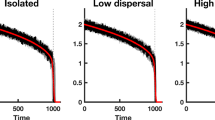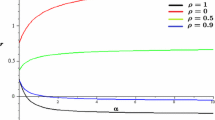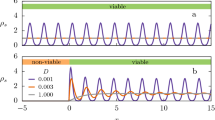Abstract
Understanding the causes and effects of spatial aggregation is one of the most fundamental problems in ecology. Aggregation is an emergent phenomenon arising from the interactions between the individuals of the population, able to sense only—at most—local densities of their cohorts. Thus, taking into account the individual-level interactions and fluctuations is essential to reach a correct description of the population. Classic deterministic equations are suitable to describe some aspects of the population, but leave out features related to the stochasticity inherent to the discreteness of the individuals. Stochastic equations for the population do account for these fluctuation-generated effects by means of demographic noise terms but, owing to their complexity, they can be difficult (or, at times, impossible) to deal with. Even when they can be written in a simple form, they are still difficult to numerically integrate due to the presence of the “square-root” intrinsic noise. In this paper, we discuss a simple way to add the effect of demographic stochasticity to three classic, deterministic ecological examples where aggregation plays an important role. We study the resulting equations using a recently-introduced integration scheme especially devised to integrate numerically stochastic equations with demographic noise. Aimed at scrutinizing the ability of these stochastic examples to show aggregation, we find that the three systems not only show patchy configurations, but also undergo a phase transition belonging to the directed percolation universality class.





Similar content being viewed by others
Notes
Even worse, in some cases, the described derivation of continuous approaches relying on standard field-theoretical techniques does not produce any Langevin equation, i.e. the resulting generating functional cannot be cast into any standard stochastic equation.
In the assumption of D and D 2 being constant, it is implicitly assumed that there is no intraspecific variability or other kind of heterogeneity in the distribution of these dispersal rates.
Of course, active aggregation must be added on top of this to bring the patterns to a more realistic scenario. However, our objective is to show that there may be two complementary origins of pattern that must be integrated, one arising from stochastic demographic fluctuations and the other owing to active aggregation.
References
Durrett, R., Levin, S.A.: The importance of being discrete (and spatial). Theor. Popul. Biol. 46, 363–394 (1994)
Cantrell, R.S., Cosner, C.: Deriving reaction-diffusion models in ecology from interacting particle systems. J. Math. Biol. 48, 187–217 (2004)
Amit, D., Martín-Mayor, V.: Field Theory, the Renormalization Group, and Critical Phenomena, 3rd edn. World Scientific, Singapore (2005)
Turing, A.M.: The chemical basis of morphogenesis. Philos. Trans. R. Soc. Lond., Ser. B 237, 37–72 (1952)
Steele, J.: Spatial heterogeinity and population stability. Nature 248, 83 (1974)
Okubo, A.: Tech. Rept 86, Chesapeake Bay Inst. Johns Hopkins University, Baltimore (1974)
Levin, S.A., Segel, L.A.: Hypothesis for origin of planktonic patchiness. Nature 259, 659 (1976)
Steele, J., Henderson, E.W.: A simple model for plankton patchiness. J. Plankton Res. 14, 1397–1403 (1992)
Butler, T., Goldenfeld, N.: Robust ecological pattern formation induced by demographic noise. Phys. Rev. E 80, 030902(R) (2009)
Butler, T., Goldenfeld, N.: Fluctuation-driven Turing patterns. Phys. Rev. E 84, 011112 (2011)
Doi, M.: Second quantization representation for classical many-particle systems. J. Phys. A 9, 1465–1479 (1976)
Peliti, L.: Path integral approach to birth-death processes on a lattice. J. Phys. 46, 1469–1483 (1985)
Grassberger, P., Scheunert, M.: Fock-space methods for identical classical objects. Fortschr. Phys. 28, 547–578 (1980)
DeDominicis, C.J.: Techniques de renormalisation de la théorie des champs et dynamique des phénomènes critiques. J. Phys. 37, 247–257 (1976)
Janssen, H.K.: On a Lagrangian for classical field dynamics and renormalization group calculations of dynamical critical properties. Z. Phys. B 23, 377–380 (1976)
Martin, P.C., Siggia, E.D., Rose, H.A.: Statistical dynamics of classical systems. Phys. Rev. A 8, 423–437 (1973)
Klausmeier, C.: Regular and irregular patterns in semiarid vegetation. Science 284, 1826–1828 (1999)
von Hardenberg, J., Meron, E., Shachak, M., Zarmi, Y.: Diversity of vegetation patterns and desertification. Phys. Rev. Lett. 87(198101), 1–4 (2001)
Manor, A., Shnerb, N.M.: Facilitation, competition, and vegetation patchiness from scale free distribution to patterns. J. Theor. Biol. 253, 838–842 (2008)
Hernández-García, E., López, C.: Clustering, advection and patterns in a model of population dynamics with neighborhood-dependent rates. Phys. Rev. E 70, 016216 (2004)
López, C., Hernández-García, E.: Fluctuations impact on a pattern-forming model of population dynamics with non-local interactions. Physica D 199, 223–234 (2004)
Hernández-García, E., López, C.: Birth, death and diffusion of interacting particles. J. Phys. Condens. Matter 17, S4263–4274 (2005)
Ramos, F., López, C., Hernández-García, E., Muñoz, M.A.: Crystallization and melting of bacteria colonies and Brownian bugs. Phys. Rev. E 77, 011116 (2008)
Täuber, U.C.: Stochastic population oscillations in spatial predator-prey models. J. Phys. Conf. Ser. 319, 012019 (2011)
Dickman, R.: Numerical study of a field theory for directed percolation. Phys. Rev. E 50, 4404–4409 (1994)
Dornic, I., Chaté, H., Muñoz, M.A.: Integration of Langevin equations with multiplicative noise and the viability of field theories for absorbing phase transitions. Phys. Rev. Lett. 94, 100601 (2005)
Moro, E.: Numerical schemes for continuum models of reaction-diffusion systems subject to internal noise. Phys. Rev. E 70, 045102(R) (2004)
Hinrichsen, H.: Nonequilibrium critical phenomena and phase transitions into absorbing states. Adv. Phys. 49, 815–958 (2000)
Odor, G.: Universality classes in nonequilibrium lattice systems. Rev. Mod. Phys. 76, 663–724 (2004)
Grinstein, G., Muñoz, M.A.: In: Garrido, P., Marro, J. (eds.) Fourth Granada Lectures in Computational Physics. Lecture Notes in Physics, vol. 493, p. 223. Springer, Berlin (1997)
Marro, J., Dickman, R.: Nonequilibrium Phase Transitions in Lattice Models. Cambridge University Press, Cambridge (1999)
Van Kampen, N.G.: Stochastic Processes in Physics and Chemistry, 6th edn. North-Holland, Elsevier, Amsterdam (1990)
McKane, A.J., Newman, T.J.: Predator-prey cycles from resonant amplification of demographic stochasticity. Phys. Rev. Lett. 94, 218102 (2005)
Levin, S.A., Withfield, M.: Patchiness in marine and terrestrial systems from individuals to populations. Philos. Trans. R. Soc. Lond. B, Biol. Sci. 343, 99–103 (1994)
Shnerb, N.M., Sarah, P., Lavee, H., Solomon, S.: Reactive glass and vegetation patterns. Phys. Rev. Lett. 90, 038101 (2003)
Shnerb, N.M.: Pattern formation and nonlocal logistic growth. Phys. Rev. E 69, 061917 (2004)
Manor, A., Shnerb, M.N.: Dynamical failure of Turing patterns. Europhys. Lett. 74, 837–843 (2006)
Fuentes, M.A., Kuperman, M.N., Kenkre, V.M.: Nonlocal interaction effects on pattern formation in population dynamics. Phys. Rev. Lett. 91, 158104 (2003)
Sayama, M.A., de Aguiar, M., Bar-Yam, Y., Baranger, M.: Spontaneous pattern formation and genetic invasion in locally mating and competing populations. Phys. Rev. E 65, 051919 (2002)
Maruvka, Y.E. Shnerb, N.M.: Nonlocal competition and logistic growth: patterns, defects, and fronts. Phys. Rev. E73, 011903 (2006)
Pigolotti, S., López, C., Hernández-García, E.: Species clustering in competitive Lotka-Volterra models. Phys. Rev. Lett. 98, 258101 (2007)
Levin, S.A., Segel, L.A.: Pattern generation in space and aspect. SIAM Rev. 27, 2–67 (1985)
Brigatti, E., Schwammle, V., Neto, M.A.: Individual-based model with global competition interaction: fluctuation effects in pattern formation. Phys. Rev. E 77, 021914 (2008)
Janssen, H.K.: On the nonequilibrium phase transition in reaction-diffusion systems with an absorbing stationary state. Z. Phys. B 42, 151–154 (1981)
Grassberger, P.: On phase transitions in Schlögl’s second model. Z. Phys. B 47, 365–374 (1982)
Muñoz, M.A., Grinstein, G., Dickman, R., Livi, R.: Critical behavior of systems with many absorbing states. Phys. Rev. Lett. 76, 451–454 (1996)
Muñoz, M.A., Grinstein, G., Dickman, R.: Phase diagram of systems with an infinite number of absorbing states. J. Stat. Phys. 91, 541–569 (1998)
Muñoz, M.A., Grinstein, G., Dickman, R., Livi, R.: Infinite numbers of absorbing states: critical behavior. Physica D 103, 485–490 (1997)
Grinstein, G., Lai, Z.-W., Browne, D.A.: Critical phenomena in a nonequilibrium model of heterogeneous catalysis. Phys. Rev. A 40, 4820–4823 (1989)
Janssen, H.K.: Directed percolation with colors and flavors. J. Stat. Phys. 103, 801–839 (2001)
Vespignani, A., Dickman, R., Muñoz, M.A., Zapperi, S.: Driving, conservation and absorbing states in sandpiles. Phys. Rev. Lett. 81, 5676–5679 (1998)
Dickman, R., Muñoz, M.A., Vespignani, A., Zapperi, S.: Paths to self-organized-criticality. Braz. J. Phys. 30, 27–41 (2000)
Vespignani, A., Dickman, R., Muñoz, M.A., Zapperi, S.: Absorbing phase transitions in fixed-energy sandpiles. Phys. Rev. E 62, 4564–4582 (2000)
Maia, D.S., Dickman, R.: Diffusive epidemic process: theory and simulation. J. Phys. Condens. Matter 19, 065143 (2007)
van Wijland, F., Oerding, K., Hilhorst, H.J.: Wilson renormalization of a reaction-diffusion process. Physica A 251, 179–201 (1998)
Lübeck, S.: Universal scaling behavior of non-equilibrium phase transitions. Int. J. Mod. Phys. B 18, 3977 (2004)
Muñoz, M.A., Dickman, R., Vespignani, A., Zapperi, S.: Avalanche and spreading exponents in systems with absorbing states. Phys. Rev. E 59, 6175–6179 (1999)
López, C., Ramos, F., Hernández-García, E.: An absorbing phase transition from a structured active particle phase. J. Phys. Condens. Matter 19, 065133 (2007)
Acknowledgements
We gratefully acknowledge support from the Cooperative Institute for Climate Science (CICS) of Princeton University and the National Oceanographic and Atmospheric Administration’s (NOAA) Geophysical Fluid Dynamics Laboratory (GFDL), the National Science Foundation (NSF) under grant OCE-1046001, the Spanish MICINN-FEDER under project FIS2009-08451, and from Junta de Andalucía (Proyecto de Excelencia P09FQM-4682). MAM thanks I. Dornic, H. Chaté and, C. López, and F. Ramos, for a long term collaboration on some of the issues presented here.
Author information
Authors and Affiliations
Corresponding author
Appendix
Appendix
We have numerically shown that the critical exponents measured in all of the examples discussed in this paper are directed-percolation like. Here we justify that result by analyzing their corresponding Langevin equations Eqs. (3), Eqs. (5), and Eq. (7).
As conjectured years ago by Janssen and Grassberger [44, 45] all systems exhibiting a phase transition into a unique absorbing state, with a single-component order parameter, and no extra symmetry or conservation law, belong to the same universality class whose most distinguished representative is directed percolation (DP). In a field theoretical description this universality class is represented by the Reggeon Field theory (RFT), [44, 45] which in terms of a Langevin equation reads:
where ρ(x,t) is the density field at position x and time t, a and b are parameters, and η(x,t) is a delta-correlated Gaussian noise, 〈η(x,t)η(x′,t′)〉=Dδ(x−x′)δ(t−t′).
The previous conjecture was confirmed in a large number of computer simulations, series expansion analysis, field theoretical studies, etc. Indeed, the DP universality class has proved to be extremely robust against the modification of many details in the microscopic models. The conjecture of universality has been extended systems with an infinite number of absorbing states [46, 47] (see also [48]). Also, Grinstein et al. extended the conjecture to the case of multicomponent systems [49] (see also [50]). Considering, for the sake of simplicity a two-component system with absorbing states, it can generically be described by a set of Langevin equations whose linearized dynamics (ignoring the Laplacian terms and the noise) is generically:
and diagonalizing the matrix of the linear coefficients:
where λ 1 and λ 2 are the associated eigenvalues and ξ 1 and ξ 2 are the corresponding eigenvectors. The existence of the absorbing state implies that the two eigenvalues are negative. At the critical point one of the two eigenvalues, say λ 1 vanishes. If the other one does not, it remains negative, and then fluctuations in ξ 2 continue to decay exponentially with time. This implies that ξ 2 does not experience critical fluctuations in the vicinity of the transition, and so can be integrated out of the problem. Hence, asymptotically, the set of Langevin equations can be reduced to single relevant equation which is precisely Eq. (9), ensuing DP behavior.
On the other hand, if the secondary field is conserved (which, in particular, enforces a 2,1 and a 2,2 to vanish) or there is a hidden symmetry imposing λ 1 and λ 2 to vanish at the same point, this conclusion can break down. In both of these cases, at the system critical point, the two fields are simultaneously critical (or “massless” or “gapless” using the field theory jargon).
Systems in which the density field is coupled to a secondary conserved field indeed exhibit non-DP critical behavior. This is the case of, for instance, (i) systems related to self-organized criticality in which the activity field is coupled to a conserved non-diffusive background field [51–53] and (ii) systems in which the secondary field is conserved but diffusive [54, 55].
Let us now return to the three models discussed in this paper.
-
(a)
Let us first scrutinize the simpler case of vegetation patterns as described by Eqs. (5). At the critical point the expectation value of ρ vanishes, while ϕ converges on average to a value R/κ and, for generic values of ρ, it converges to ϕ st =(R−w 2 ρ)/κ. Let us remark that these are the noiseless or mean-field expectation values. Defining a new field ψ=ϕ−ϕ st and linearizing the dynamics as above, it is straightforward to see that this is an instance of the non-symmetric case discussed above in which the linear terms in both equations do not vanish simultaneously: DP behavior is predicted. Observe also that, after shifting the secondary field, a standard saturation term proportional to −ρ 2 appears in the first equation, i.e. the competition for the available resource (water) acts as an inhibitor generating the necessary effective carrying capacity term (see main text).
-
(b)
The case of the stochastic Levin-Segel model, as defined by Eqs. (3) is a bit trickier. Observe that on average one expects (at a noiseless or mean-field level) ϕ=ρw 2/λ, which implies that when ρ vanishes so does ϕ opening the door to non-DP scaling. However, closer inspection reveals that the noise in the equation for ϕ is a higher order one as it is proportional to \(\sqrt{\rho\phi}\). It is therefore irrelevant in the renormalization group sense around the DP-like fixed point (indeed, we have verified numerically that the critical exponents of the modified version of Eqs. (3) without such a term coincide, within error bars, with those of the original ones—results not shown). In this way, the equation for ∂ t ϕ becomes asymptotically a deterministic one. Then, ϕ(x) can be written as a function of ρ(x,t), i.e. ϕ(x,t)=F(ρ(x,t)) where F is an unspecified function which can be formally obtained by integration of the equation for ∂ t ϕ. Expanding such a function in power series of ρ, plugging in the result in the equation for ∂ t ρ and neglecting higher-order terms, one readily recovers Eq. (9), and hence DP scaling. The field ϕ is just a slave mode of ρ (proportional to it up to leading order), inheriting all its critical properties from it.
-
(c)
Finally, for the non-local Langevin model for Brownian bugs, it is easy to see that by performing a coarse graining in which scales below l are scaled-up, one recovers effectively Eq. (9). The main point is that nonlocal but finite-range interaction becomes local in the renormalization group perspective once a sufficient amount of coarse graining has been considered. See [23] for further details.
Rights and permissions
About this article
Cite this article
Bonachela, J.A., Muñoz, M.A. & Levin, S.A. Patchiness and Demographic Noise in Three Ecological Examples. J Stat Phys 148, 724–740 (2012). https://doi.org/10.1007/s10955-012-0506-x
Received:
Accepted:
Published:
Issue Date:
DOI: https://doi.org/10.1007/s10955-012-0506-x




